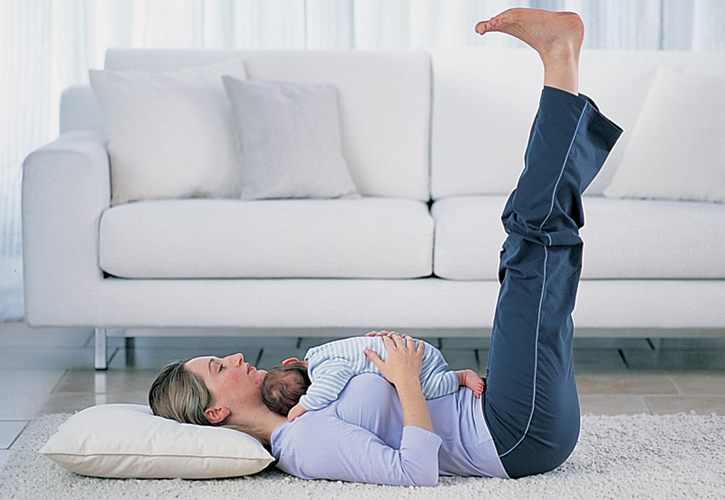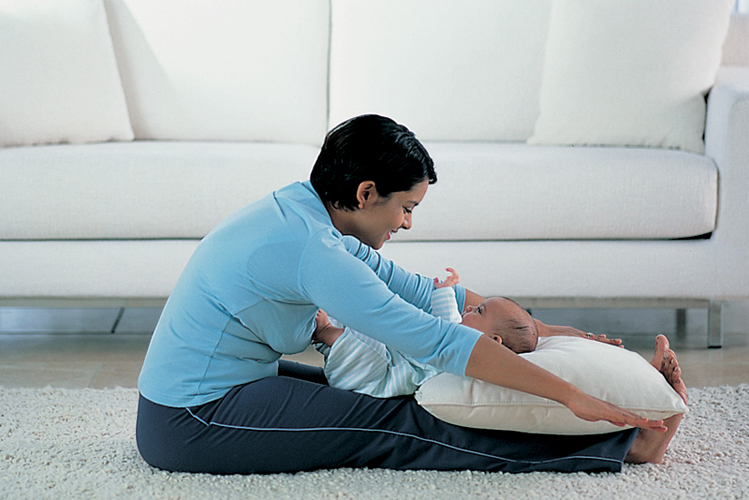Getting enough rest Helping your body to recover
Whether you had a
vaginal or cesarean birth, you are likely to feel exhausted in the
first few weeks. It's important that you don't take on too much and give
yourself time to recover.
Rather than try and catch up on chores while your baby sleeps, take a nap to catch up on sleep lost through interrupted nights.
Avoid heavy lifting as much as possible.
It's fine to take things at your own pace while you get used to life with your new baby.
Don't feel you have to entertain visitors—ask them to make you a cup of tea!
Coping with constipation Helping your bowels work after the birth
It's common for the
bowel to be fairly sluggish after giving birth as your abdominal muscles
have been stretched during pregnancy and so exert less pressure, which
slows down the movement through the bowels.
You may also
feel uncomfortable after the birth and be anxious that opening your
bowels, and possibly straining, could damage stitches if you had any.
However, this is extremely unlikely. The best way to avoid constipation
is to drink plenty of fluids each day, preferably water (also important
if you are breast-feeding), and to eat lots of fiber-rich foods, such as
fresh and dried fruits, cereals, and other whole-grain foods. Once you
have recovered from the birth, gentle exercise that tones the abdominal
muscles may also help your bowels become more efficient (see Postpartum exercise).
A balanced diet
It's easy to neglect your
diet once your baby arrives, since you find that you are too tired to
prepare proper meals and perhaps think it less important to watch what
you eat, now that your baby is outside the uterus. However, eating a
healthy diet now is as crucial as ever. If you are breast-feeding, you
need to eat a nutritious balanced diet and drink plenty of fluids to
ensure a good milk production. Eating well also gives you the energy to
deal with interrupted sleep and the demands of your new baby. Make sure
your diet contains plenty of protein and carbohydrates, as well as foods
rich in calcium, such as eggs and dairy, and iron-rich foods, such as
green leafy vegetables. Avoid sugary and salty foods and snack instead
on fresh fruit.
Nutritious meals:
You may find it easier
to eat little and often to keep your energy levels up. Opt for light,
easy-to-prepare meals, such as salads or whole-wheat bread sandwiches.

After an episiotomy How to ease the discomfort of stitches
If you had an
episiotomy, you may find that your perineum is quite uncomfortable
after the birth, as the surrounding skin can swell, causing the stitches
to become tighter, and sitting down becomes increasingly difficult.
Here are some ways to relieve this discomfort.
Sit on a rubber ring to take the pressure off your stitches and enable you to relax.
Apply a cooling gel pack to the area, or ask your midwife or doctor to recommend an anesthetic cream or spray.
Try
squatting over the toilet seat when you urinate since this helps
prevent acidic urine from running over your stitches. Pour warm water
over then dry the area after using the toilet.
A warm bath or shower can be soothing. After washing, dry the area carefully by patting the area gently with a towel.
NOTE
Take heart—you will lose your baby weight, although not overnight. Why not try power walking with other new moms?
NOTE
Carve out some “me” time each day: a warm soak, or a lie down. Taking care of yourself helps you give your best to your baby
Postpartum exercise Getting into shape
You can exercise as soon as
you want to after your baby's birth. The amount you do and how
strenuous the exercise will depend on the type of birth you had and how
much you exercised before you had your baby. Other considerations are
whether you are breast-feeding and the amount of discomfort you feel.
Always listen to your body since you will become uncomfortable if you do
too much. Your body has just undergone an enormous change throughout
the course of pregnancy and childbirth, particularly if you had a
cesarean section. There are also high levels of hormones still in your
body, which can make you more supple and prone to injury. If you are
breast-feeding, you may just want to do gentle exercising until feeding
is established. It's a good idea to wear a supportive bra while
exercising, and exercise following a feeding rather than before one,
which may make it more comfortable for you. Always warm up, wear the
correct footwear, and drink plenty of fluids while you are exercising.
Stop and seek medical advice if you feel unwell or experience any severe
pain or your bleeding increases. Although getting back to your
pre-pregnancy shape is important for your well-being, be patient with
yourself; it will take time.
| Q: |
Which exercises can I do?
|
| A: |
Kegel (pelvic floor) exercises
can start right after the birth
. These important exercises help prevent you from leaking urine
when you laugh, cough, or sneeze. The exercises involve drawing up and
holding the pelvic floor muscles, tightening around the back and front
passages, and then letting go. Make sure that you are tightening the
pelvic floor (not your buttocks, thighs, or stomach muscles). Keep
breathing and relax your other muscles. Kegel exercises can also be done
lying on your side or back with the knees bent and slightly apart.
Other gentle
exercises, like lying on your back with your knees bent and doing pelvic
tilts (pulling your belly-button in and upward toward your spine), are
recommended in the first few days after the birth. Your abdominal
muscles may have separated in pregnancy, so doing these gentle exercises
will help them reunite. The exercises shown here will help strengthen
abdominal muscles (avoid after a cesarean and follow the exercise advice
given by your doctor). Build up exercises gradually, starting with one
cycle and then repeating this as many times as you feel comfortable.
Always breathe normally. Walking and swimming are excellent ways to
build up your fitness levels once you have stopped bleeding.
|
| Q: |
What should I avoid in the first six weeks?
|
| A: |
Full impact and resistance exercising should only be done after
six weeks postpartum, to prevent any strain on the pelvic floor area.
Ask your fitness instructor for advice and gradually increase your
exercise. Always let your instructor know that you have just had a baby,
so exercises can be tailored to your needs. If you had a cesarean, your
doctor might have information describing the type of exercises you can
do safely and before you do abdominal exercises, such as sit-ups, check
with your doctor; these are usually safe to do around 6–8 weeks after
the birth. You can gently introduce single leg-lifts while lying on your
back with knees bent once you feel ready, probably after about a month.
|
Relaxation pose:
Lying flat on your back with your knees bent and your head supported by a cushion is extremely relaxing for your lower back.

Exercises for 0–6 weeks
Abdominal exercise:
Lie on your back with a
cushion supporting your head; bend your knees and place your feet on the
floor. Draw your knees up to your chest, holding them with your hands.
Breathe deeply into your abdomen.

Advanced abdominal exercise:
If you are able, lift
your legs up toward the ceiling. You can keep the knees slightly bent,
or straighten them if possible. Focus on your breathing and pull up your
pelvic floor muscles in time with your breaths.

Exercises for 6–16 weeks
Sitting twist:
Sit upright; bend your
left knee, your foot flat on the floor. Place your left hand behind you,
then exhale and turn your torso. Repeat the other side.

Easy forward bend:
Sit with your legs straight in front of you. Raise your arms, then exhale and reach forward, extending from the hips.

Twisting forward bend:
Cross your legs with
the right knee resting on the left knee. Lift your arms, palms joined,
and stretch forward, your back straight.

Myths and misconceptions Is it true that…
| Q: |
Crying is good for your baby's lungs?
|
| A: |
Don't listen to this well-meant but misguided advice—if your baby is crying there is usually a good reason.
As any mother knows, a baby's cry can mean, “Feed me,” “I'm lonely,”
“I'm over-tired,” “I'm in pain.” “I'm wet and need changing,” or even
“I've been over stimulated, leave me alone.” Crying is your baby's way
of communicating something to you, and it is natural and healthy to
respond to it.
|
| Q: |
You can become addicted to pills for postpartum depression?
|
| A: |
Don't worry about getting addicted. Postpartum depression is serious and distressing, but it is treatable.
Antidepressants (usually prescribed alongside other talking therapies)
are not considered to be addictive, and you will have the chance to
discuss any concerns with your doctor. However, you are recommended to
take them for about six months and not to stop taking them abruptly.
|
| Q: |
Babies can be spoiled if held too much?
|
| A: |
Unlikely.
During your baby's first few months, holding him makes him feel loved
and secure. While some babies don't seem to need much close physical
contact, others want to be held all the time.
If your baby needs a lot of holding, you can try a baby carrier or
sling, which allows you to keep him close to you while leaving your
hands free for other tasks. But when your baby is quiet and calm, let
him entertain himself or fall asleep on his own.
|